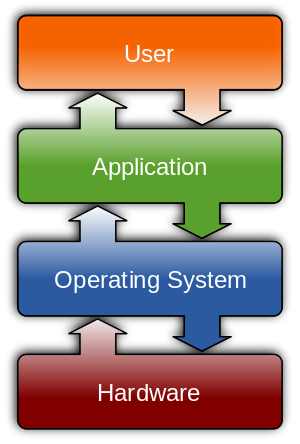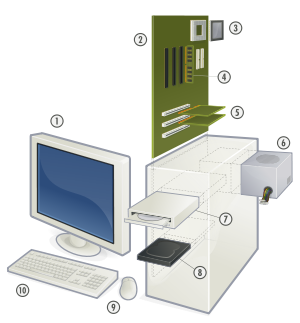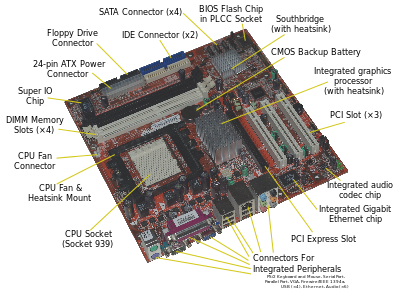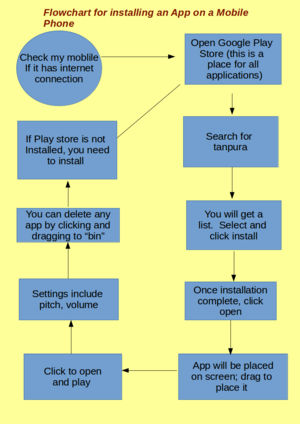Difference between revisions of "ICT student textbook/How is a computer different from a fridge"
Jump to navigation
Jump to search
m |
|||
| Line 9: | Line 9: | ||
<big><u>{{font color|brown|'''How is a computer different from a fridge'''}}</u></big> | <big><u>{{font color|brown|'''How is a computer different from a fridge'''}}</u></big> | ||
| − | {{font color|brown|In this activity, you will develop an appreciation of what the computer is | + | {{font color|brown|In this activity, you will develop an appreciation of what the computer is and what makes the computer work.}} |
==={{font color|purple|Check your readiness}}=== | ==={{font color|purple|Check your readiness}}=== | ||
| Line 16: | Line 16: | ||
==={{font color|purple|What resources do you need}}=== | ==={{font color|purple|What resources do you need}}=== | ||
#Working computer lab | #Working computer lab | ||
| − | # | + | #Computers installed with [[Learn Ubuntu|Ubuntu Operating System]] |
| − | # | + | #[[Explore_a_computer|Projector]] |
#Images to show of the computer | #Images to show of the computer | ||
#Handout for [[ICT_teacher_handbook/Basic_digital_literacy|Basic digital literacy]] | #Handout for [[ICT_teacher_handbook/Basic_digital_literacy|Basic digital literacy]] | ||
| Line 23: | Line 23: | ||
==={{font color|purple|What digital skills will you learn}}=== | ==={{font color|purple|What digital skills will you learn}}=== | ||
| − | #Getting familiar with an ICT environment and different kinds of ICT devices | + | #Getting familiar with an [[Explore_a_computer|ICT environment]] and different kinds of ICT devices |
| − | #Operating a computer safely | + | #Operating a computer [[Explore_a_computer|safely]] |
| − | #Understanding the difference between operating system software and application software | + | #Understanding the [[Learn_Ubuntu#Overview_of_Features|difference between operating system software and application software]] |
==={{font color|purple|Description of activity with detailed steps}}=== | ==={{font color|purple|Description of activity with detailed steps}}=== | ||
====Teacher-led component==== | ====Teacher-led component==== | ||
#Your teacher may ask you, in small groups, to make a of list all the items a fridge does and a list of all the things you think a computer can do. | #Your teacher may ask you, in small groups, to make a of list all the items a fridge does and a list of all the things you think a computer can do. | ||
| − | #In a group activity your teacher will compile all the group comments in a digital mind map using a concept mapping tool. | + | #In a group activity your teacher will compile all the group comments in a digital mind map using a concept mapping tool. She will encourage you to classify the various things the computer will do. |
| − | #The teacher will discuss why an operating system needed is and how it works with different applications | + | #The teacher will discuss why an operating system needed is and how it works with different applications, for processing your inputs and providing outputs. |
#With the help of a schematic the teacher will discuss the parts of a computer. | #With the help of a schematic the teacher will discuss the parts of a computer. | ||
Revision as of 16:58, 29 December 2016
How is a computer different from a fridge
In this activity, you will develop an appreciation of what the computer is and what makes the computer work.
Check your readiness
This is the first activity; so no previous knowledge is assumed.
What resources do you need
- Working computer lab
- Computers installed with Ubuntu Operating System
- Projector
- Images to show of the computer
- Handout for Basic digital literacy
- Handout for Freeplane
What digital skills will you learn
- Getting familiar with an ICT environment and different kinds of ICT devices
- Operating a computer safely
- Understanding the difference between operating system software and application software
Description of activity with detailed steps
Teacher-led component
- Your teacher may ask you, in small groups, to make a of list all the items a fridge does and a list of all the things you think a computer can do.
- In a group activity your teacher will compile all the group comments in a digital mind map using a concept mapping tool. She will encourage you to classify the various things the computer will do.
- The teacher will discuss why an operating system needed is and how it works with different applications, for processing your inputs and providing outputs.
- With the help of a schematic the teacher will discuss the parts of a computer.

|

|

|
Do you know the parts of a personal computer
- Monitor
- Motherboard
- Central Processing Unit
- Main Memory - Random Access Memory
- Expansion cards
- Power Supply Unit
- Optical Disk Drive
- Hard Disk Drive (HDD)
- Mouse
- Keyboard
Student activities
- In small groups, with teacher guidance, you can switch on a computer and identify the parts you are familiar with
- The teacher will help you create a folder on your computer, for saving your work done in the class.
- With your friends, compare a mobile phone and the computer and list the things each does. Discuss with your friends if there is any difference.
- Develop a flowchart for any activity you have done, or seen someone do. It is better if this is an ICT activity - it can be using the phone, using the computer, playing a video on the TV, etc. See on the side for an example of a flowchart. What you see here is a flowchart for downloading an app on the phone. This has been developed using an application software called LibreOffice Draw, and converted into an image format. You can develop a similar flowchart.
- In groups, you can draw concept map for the following things (your teacher will discuss with you additional activities):
- Connecting a TV to a cable network
- Using phones to book cooking gas
- Using the farmer SMS service from MKisan portal
- With the help of your teacher, take photographs of the charts and concept maps created, using a cell phone or a digital camera.
Portfolio
We saw earlier that you will keep adding to your digital outputs during this course.
- You will begin your portfolio collection with the digitized mind maps/ charts.
- Create a folder with your name and start saving your files.

